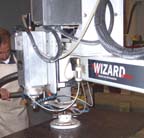

So, you fire-up the air polisher again. Within four to five minutes, the scratch is gone, but in its place is a shallow bowl and a vaguely grayish area where the scratch was. It looks okay (you suppose) but you wouldn't be happy if this piece was installed in your house. You rub a little wax on it, all while hoping that your customer doesn't have a kitchen bay window, under-cabinet lighting, or a discerning eye.
Another scenario: you take delivery of several special order exotic slabs needed to fabricate a large kitchen. The turnaround time on the slab order was four weeks, and the kitchen installation was scheduled for two weeks. Due to some shifting during shipping, you are horrified to find that half the slabs have been damaged with mild scratches running the entire width of the slabs. So, you send the slabs back and reach for the phone to call your customer. You tell her that it will take four weeks to get the new slabs delivered, plus an additional three days to fabricate. So, she should get the kitchen in a little over a month. You hang up, hoping that her next call isn't to her bridge club, telling them all about your company's inability to deliver on time.
It probably didn't take a lot of imagination to find yourself in these predicaments. Surface scratches, gouges and other blemishes can cost your company thousands of dollars a year. Replacing slabs, reworking pieces, and late deliveries cannot only hurt your bottom line, but your reputation as well. While we may not be able to prevent all of these problems, we can fix them in the fastest, most effective way possible.
We've all used air or electric polishers to repair scratches in slabs, most likely with varying degrees of success. Dimples, waves and divots are generally the order of the day when trying to fix deeper scratches, while battling to match the factory finish with powders, pads and pastes plague the rest. There is usually a common problem when you polish surfaces with hand polishers: uneven pressure and uneven tool contact. It's very difficult to maintain constant and repeatable pressure on a 4-inch abrasive pad, and a person's flexible nature does not generally allow for good, even tool-to-stone contact.
So what can we use that will give us even polishing pressure that can be varied to fit the circumstances and aid in maintaining consistent tool contact throughout the polishing process? One solution is a radial arm workstation. Once called radial arm polishers, these multi-functional tools were initially designed solely to grind and polish slabs and monuments, capable of putting a glossy, flat finish on a variety of different materials. Generally speaking, these machines have a variable speed spindle that has roughly 6 inches of rise-and-fall travel used to hold and rotate the tooling. Additionally, the spindle should have variable pressure settings, which are critical to face polishing. Typically, a well-trained operator using a good set of 8- or 10-inch tools can bring the rough back side of a granite slab up to a matching factory finish in as little as five minutes per square foot.
This is not to say that these machines are designed to polish full slabs of material; quite the contrary. Most radial arm workstations have a working area of roughly 18 to 20 square feet, with the working length determined by the width of the piece. However, the consistency of the polish coming off of the machine is such that slabs may be cut to desired size prior to re-polish or repair and polished individually to a matching finish.
Although capable of refinishing full countertop runs, spot repairs are the best applications for these machines. A small scratch in even the most difficult of stones is usually repaired in a matter of minutes, with none of the cupping, rippling or hazing normally associated with traditional scratch repair methods. Using a set of 8-inch polishing wheels (4-inch wheels are available for more restricted areas), a 5-inch-long scratch that is deep enough to catch a fingernail can be ground out and re-polished in less than five minutes.
When it comes to fabricating marble, a radial arm workstation is doubly important. As those of you who fabricate marble know, it is not “if,†but “when†you will to need to repair a workpiece. Cracks, mud veins, scratches and breaks all require refinishing.
It does not end with slab polishing and repair, since the polishing feature of a radial arm workstation can be put to other uses. For example, a customer who desires a honed finish on a given material can be done with your existing inventory. There is no need to place a special order for honed slabs if you have a radial arm machine. Honing a slab can be done quite rapidly, and typically requires only one tool to break down the polish. Another example would be polishing the backsplash. A 4-inch backsplash can be cut out of a full slab, placed on edge and clamped together 6 to 10 pieces wide. Then, running the same tools used for surface polishing, the entire block can be polished simultaneously. Upwards of 80 to 120 feet of backsplash can be polished in an hour's time, remembering that the front edge will still need to be broken by hand. Aside from the obvious time advantages to polishing multiple pieces at once, the backsplashes will also be ground down to the same height by the polishing heads. This reduces the necessity of shimming the backsplash pieces and the time spent installing.
As the radial arm workstation evolved from polisher to a multi-function platform, new tools and techniques have became available to add to the capabilities of these machines. For example, a good radial arm workstation should be able to core fixture holes, shape edges using router bits, grind and polish slopes, recesses and drain boards, texture stones using brushes and bushhammers, shape inside and outside radiuses and process and polish sink cutouts. The best radial arm polishers will have an independent spindle for cutting sinkholes prior to processing and polishing.
For those of you who are already using a radial arm workstation to polish or repair slabs, here are a few tips to help get the most out of your polishing efforts:
Properly used, a radial arm workstation can be the centerpiece of a small fabrication shop, a reliable backup to a CNC workcenter, or a speedy method of repairing slabs in any size shop.